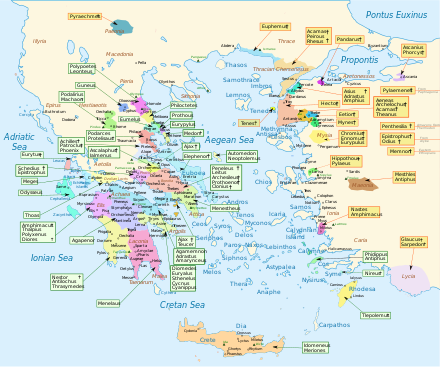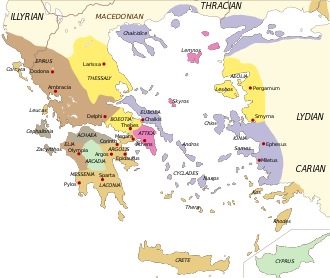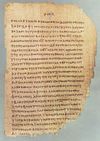اللغة اليونانية القديمة
| اليونانية القديمة Ancient Greek | |
|---|---|
| Ἑλληνική Hellēnikḗ | |
| المنطقة | شرق المتوسط |
| الحقبة | تطورت إلى يونانية كوينه بحلول القرن 4 ق.م. |
الهندو-اوروبية
| |
| الأبجدية اليونانية | |
| أكواد اللغات | |
| ISO 639-2 | grc |
| ISO 639-2 | grc |
| ISO 639-3 | grc |
 خريطة اليونان الهومرية | |
اليونانية القديمة Ancient Greek، هي صيغة من اللغة اليونانية كانت تسخدم في الفترات الممتدة من ح. القرن 9 حتى القرن 6 ق.م، (تُعرف بالأرتشياكية)، ح. القرن 5 حتى القرن 4 ق.م (الكلاسيكية)، وح. القرن 3 ق.م حتى القرن السادس الميلادي (الهلينية)، في اليونان القديمة والعالم القديم. كان يسبقها في الألفية الثانية قبل الميلاد اليونانية الميسينية. كانت اللغة المستخدمة في المرحلة الهلينية تعرف بالكونه (الشائعة) أو اليونانية التوراتية، بينما اللغة التي كانت تستخدم في أواخر هذه الفترة فصاعداً بيونانية العصور الوسطى. تعتبر الكونيه مرحلة تاريخية منفصلة ومستقلة بذاتها، بالرغم من أن الصيغ المبكرة منها، كانت قريبة من اليونانية الكلاسيكية. قبل الفترة الكوينية، كانت يونانية الفترات الكلاسيكية والمبكرة تتضمن لهجات محلية مختلفة.
كانت اليونانية القديمة لغة هومر والمؤرخين الأثينيين الكلاسيكيين، المسرحيين، والفلاسفة. أسهمت اليونانية القديمة في الكثير من كلمات المفردات الإنگليزية وكانت موضوع معياري للدراسة في المعاهد التعليمية في الغرب منذ عصر النهضة. يحتوي هذا المقال بصفة رئيسية على معلومات عن المراحل الملحمية والكلاسيكية لليونانية القديمة.
اللهجات
الأصول، الصيغة المبكرة وتطوير لعائلة اللغة الهلينية غير مفهومة جيداً لافتقاد الأدلة المعاصرة. يوجد نظريات مختلفة عن مجموعة اللهجات الهلينية والتي ربما كانت موجودة ضمن الخطاب اليوناني المبكر من اللغة الهندية الأوروبية البدائية الشائعة. وتشترك جميعها في الأطر العامة لكنها تختلف في بعض التفاصيل. اللهجة الوحيدة الموثقة في تلك الفترة[1] هي الميسانية، لكن علاقتها باللهجات والملابسات التاريخية يعني أن مجموعات اللهجات جميعها كانت موجودة بالفعل في بعض الصيغ التاريخية للغة اليونانية
الصيغة الموحدة لتلك اللهجات هي:[2]
 توزيع اللهجات اليونانية في الفترة الكلاسيكية.[3]
|
| ||||||
تغير الصوت
| الأبجدية اليونانية | |||
|---|---|---|---|
| Αα | ألفا | Νν | نو |
| Ββ | بيتا | Ξξ | Xi |
| Γγ | گاما | Οο | اوميكرون |
| Δδ | دلتا | Ππ | پاي |
| Εε | Epsilon | Ρρ | Rho |
| Ζζ | زيتا | Σσς | سيگما |
| Ηη | إيتا | Ττ | تاو |
| Θθ | ثيتا | Υυ | Upsilon |
| Ιι | إيوتا | Φφ | في |
| Κκ | كاپا | Χχ | Chi |
| Λλ | لامبدا | Ψψ | پسي |
| Μμ | مو | Ωω | اوميگا |
| التاريخ | |||
| المتغيرات المحلية القديمة | |||
| في لغات أخرى | |||
| الرموز العلمية | |||
|
| |||
انظر اليونانية البدائية من وصف تغيرات الصوت عن الهندية الأوروبية البدائية مرورواً باليونانية القديمة الموثقة.
علم الصوتيات
تغير نُطق اليونانية ما بعد الكلاسيكية إلى حد كبير عن اليونانية القديمة، بالرغم من أن قواعد الإملاء لا تزال تعكس خصائص اللغة القديمة (انظر و. سيدني ألن، Vox Graeca – دليل لنطق اليونانية الكلاسيكية). للحصول على وصف مفصل لتغيرات علم الصوتيات من الفترات القديمة إلى الفترات الهلينية للغة اليونانية، انر مقال اليونانية الكونيه.
المثال التالي على اليونانية الأتيكية في القرن الخامس. بالرغم من أن النطق القديم لا يمكن اعادة بناؤه بشكل مؤكد، وبالرغم من أن اللغة اليونانية كانت موثقة بشكل جيد بدءاً من تلك الفترة، إلا أن هناك بعض الخلافات بين علماء اللسانيات حول الطبيعة العامة للأصوات التي تُنطق بها هذه الحروف.
المخزون الصوتي
الصوامت
| شفهي | أسناني | طبقي | حنجري | ||
|---|---|---|---|---|---|
| أنفي | m | n | (ŋ) | ||
| انفجاري | منطوق | b | d | ɡ | |
| صامت | p | t | k | ||
| aspirated | pʰ | tʰ | kʰ | ||
| احتكاكي | s | h | |||
| Trill | r | ||||
| جانبي | l | ||||
[ŋ] occurred as an allophone of /n/ used before velars and as an allophone of /ɡ/ before nasals. /r/ was probably voiceless when word-initial (written ῥ)
الحروف المتحركة
| Front | Back | ||
|---|---|---|---|
| unrounded | rounded | ||
| Close | i iː | y yː | |
| Close-mid | e eː | o oː | |
| Open-mid | ɛː | ɔː | |
| Open | a aː | ||
/oː/ raised to [uː], probably by the 4th century BC.
تغير الصوت
المماثلة
In verb conjugation, one consonant often comes up against the other. Various sandhi rules apply.
القواعد:
- Most basic rule: When two sounds appear next to each other, the first assimilates in voicing and aspiration to the second.
- This applies fully to stops. Fricatives assimilate only in voicing, sonorants do not assimilate.
- Before an /s/ (future, aorist stem), velars become [k], labials become [p], and dentals disappear.
- Before a /tʰ/ (aorist passive stem), velars become [kʰ], labials become [pʰ], and dentals become [s].
- Before an /m/ (perfect middle first-singular, first-plural, participle), velars become [ɡ], nasal+velar becomes [ɡ], labials become [m], dentals become [s], other sonorants remain the same.
المد
Certain vowels historically underwent compensatory lengthening in certain contexts. /a/ sometimes lengthened to [aː] or [ɛː], and /e/ and /o/ become the closed values [eː] and [oː] and the open ones [ɛː] and [ɔː] depending on time period.
Vowel shift
The Proto-Greek long vowel /aː/ was shifted to [ɛː] in the Attic dialect, except after /e i r/. In the Ionic dialect, it shifted in all environments, but in Doric and Aeolic, it did not shift at all.
المورفولوجيا
Greek, like all of the older Indo-European languages, is highly inflected. It is highly archaic in its preservation of Proto-Indo-European forms. In Ancient Greek nouns (including proper nouns) have five cases (nominative, genitive, dative, accusative and vocative), three genders (masculine, feminine and neuter), and three numbers (singular, dual and plural). Verbs have four moods (indicative, imperative, subjunctive, and optative), three voices (active, middle and passive), as well as three persons (first, second and third) and various other forms. Verbs are conjugated through seven combinations of tenses and aspect (generally simply called "tenses"): the present, future and imperfect are imperfective in aspect; the aorist (perfective aspect); a present perfect, pluperfect and future perfect. Most tenses display all four moods and three voices, although there is no future subjunctive or imperative. Also, there is no imperfect subjunctive, optative or imperative. There are infinitives and participles corresponding to the finite combinations of tense, aspect and voice.
Augment
The indicative of past tenses adds (conceptually, at least) a prefix /e-/, called the augment. This was probably originally a separate word, meaning something like "then," added because tenses in PIE had primarily aspectual meaning. The augment is added to the indicative of the aorist, imperfect and pluperfect, but not to any of the other forms of the aorist (no other forms of the imperfect and pluperfect exist).
There are two kinds of augment in Greek, syllabic and quantitative. The syllabic augment is added to stems beginning with consonants, and simply prefixes e (stems beginning with r, however, add er). The quantitative augment is added to stems beginning with vowels, and involves lengthening the vowel:
- a, ā, e, ē → ē
- i, ī → ī
- o, ō → ō
- u, ū → ū
- ai → ēi
- ei → ēi or ei
- oi → ōi
- au → ēu or au
- eu → ēu or eu
- ou → ou
Some verbs augment irregularly; the most common variation is e → ei. The irregularity can be explained diachronically by the loss of s between vowels. In verbs with a prefix, the augment is placed not at the start of the word, but between the prefix and the original verb. For example, προσ(-)βάλλω (I attack) goes to προσέβαλoν in the aorist.
Following Homer's practice, the augment is sometimes not made in poetry, especially epic poetry.
The augment sometimes substitutes for reduplication; see below.
نظام الكتابة
Ancient Greek was written in the Greek alphabet, with some variation among dialects. Early texts are written in boustrophedon style, but left-to-right became standard during the classic period. Modern editions of Ancient Greek texts are usually written with accents and breathing marks, interword spacing, modern punctuation, and sometimes mixed case, but these were all introduced later.
نص كمثال
The following polytonic Greek text is from the beginning of Apology by Plato:
- Ὅτι μὲν ὑμεῖς, ὦ ἄνδρες Άθηναῖοι, πεπόνθατε ὑπὸ τῶν ἐμῶν κατηγόρων, οὐκ οἶδα: ἐγὼ δ' οὖν καὶ αὐτὸς ὑπ' αὐτῶν ὀλίγου ἐμαυτοῦ ἐπελαθόμην, οὕτω πιθανῶς ἔλεγον. Καίτοι ἀληθές γε ὡς ἔπος εἰπεῖν οὐδὲν εἰρήκασιν.
Transliterated into the Latin alphabet using a modern version of the Erasmian scheme:
- Hóti mèn humeîs, ô ándres Athēnaîoi, pepónthate hupò tôn emôn katēgórōn, ouk oîda: egṑ d' oûn kaì autòs hup' autōn olígou emautoû epelathómēn, hoútō pithanôs élegon. Kaítoi alēthés ge hōs épos eipeîn oudèn eirḗkasin.
Using the IPA:
- hóti men hymêːs, ɔ̂ː ándres atʰɛːnáioi, pepóntʰate hypo tɔ̂ːn emɔ̂ːn katɛːgórɔːn, oːk óida; egɔ̌ː dôːn kai autos hyp autɔ̂ːn olígoː emautôː epelatʰómɛːn, hǒːtɔː pitʰanɔ̂ːs élegon. kaítoi alɛːtʰés ge hɔːs épos eːpêːn oːden eːrɛ̌ːkasin.
Translated into English:
- What you, men of Athens, have learned from my accusers, I do not know: but I, for my part, nearly forgot who I was thanks to them, since they spoke so persuasively. And yet, of the truth, they have spoken, one might say, nothing at all.
Another example, from the beginning of Homer's Iliad:
Μῆνιν ἄειδε, θεά, Πηληϊάδεω Ἀχιλῆος
οὐλομένην, ἣ μυρί’ Ἀχαιοῖς ἄλγε’ ἔθηκε,
πολλὰς δ’ ἰφθίμους ψυχὰς Ἄϊδι προΐαψεν
ἡρώων, αὐτοὺς δὲ ἑλώρια τεῦχε κύνεσσιν
οἰωνοῖσί τε πᾶσι· Διὸς δ’ ἐτελείετο βουλή·
ἐξ οὗ δὴ τὰ πρῶτα διαστήτην ἐρίσαντε
Ἀτρεΐδης τε ἄναξ ἀνδρῶν καὶ δῖος Ἀχιλλεύς.
الاستخدام الحديث
The study of Ancient Greek in European countries in addition to Latin occupied an important place in the syllabus from the Renaissance until the beginning of the 20th century. Ancient Greek is still taught as a compulsory or optional subject especially at traditional or elite schools throughout Europe, such as public schools and grammar schools in the المملكة المتحدة. It is compulsory in the Liceo classico in Italy, in the gymnasium in هولندا, in some classes in Austria, in Croatia in klasicna gimnazija and it is optional in the Humanistisches Gymnasium in Germany (usually as a third language after Latin and English, from the age of 14 to 18). In 2006/07, 15,000 pupils studied Ancient Greek in Germany according to the Federal Statistical Office of Germany, and 280,000 pupils studied it in Italy.[4] Ancient Greek is also taught at most major universities worldwide, often combined with Latin as part of Classics. It will also be taught in state primary schools in the UK, to boost children’s language skills,[5][6][7] and will be offered as a foreign language to pupils in all primary schools from 2014 as part of a major drive to boost education standards, together with Latin, Mandarin, French, German, Spanish, and Italian.[8] Ancient Greek is also taught as a compulsory subject in Gymnasia and Lykia in Greece.[9][10]
Ancient Greek is often used in the coinage of modern technical terms in the European languages: see English words of Greek origin.
طالع أيضاً
- استكشاف اللغة والثقافة اليونانية القديمة (مسابقة)
- الأبجدية اليونانية
- Greek declension
- Greek diacritics
- Mycenaean Greek language
- اليونانية الكونيه
- يونانية العصور الوسطى
- اليونانية المعاصرة
- اللغة اليونانية
- قائمة العبارات اليونانية (معظمها قديمة)
- List of Greek words with English derivatives
الهامش
- ^ Imprecisely attested and somewhat reconstructive due to its being written in an ill-fitting syllabary (Linear B).
- ^ This one appears in recent versions of the Encyclopædia Britannica, which also lists the major works that define the subject.[صفحة مطلوبة]
- ^ Roger D. Woodard (2008), "Greek dialects", in: The Ancient Languages of Europe, ed. R. D. Woodard, Cambridge: Cambridge University Press, p. 51.
- ^ [1]
- ^ Ancient Greek 'to be taught in state schools'
- ^ "Primaries go Greek to help teach English" - Education News - 30 July 2010.
- ^ "Now look, Latin's fine, but Greek might be even Beta" TES Editorial © 2010 - TSL Education Ltd.
- ^ More primary schools to offer Latin and ancient Greek, The Telegraph, 26 November 2012
- ^ http://www.fa3.gr/phys_educ_2/33-orologio-programma-Gymnasiou.htm
- ^ http://edu.klimaka.gr/leitoyrgia-sxoleivn/lykeio/755-wrologio-programma-genika-lykeia.html
للاستزادة
- P. Chantraine (1968), Dictionnaire étymologique de la langue grecque, Klincksieck, Paris.
- Athenaze A series of textbooks on Ancient Greek published for school use
- Hansen, Hardy and Quinn, Gerald M. (1992) Greek: An Intensive Course, Fordham University Press
- Easterling, P & Handley, C. Greek Scripts: An illustrated introduction. London: Society for the Promotion of Hellenic Studies, 2001. ISBN 0-902984-17-9
وصلات خارجية
- Ancient Greek Swadesh list of basic vocabulary words (from Wiktionary's Swadesh list appendix)
تعلم النحو
- A more extensive grammar of the Ancient Greek language written by J. Rietveld
- Recitation of classics books
- Perseus Greek dictionaries
- Greek-Language.com Information on the history of the Greek language, application of modern Linguistics to the study of Greek, and tools for learning Greek
- Free Lessons in Ancient Greek, Bilingual Libraries, Forum
- A critical survey of websites devoted to Ancient Greek
- Ancient Greek Tutorials Berkeley Language Center of the University of California
- A Digital Tutorial For Ancient Greek Based on White's First Greek Book
- New Testament Greek
- Acropolis World News A summary of the latest world news in Ancient Greek, Juan Coderch, University of St Andrews
نصوص كلاسيكية
- Articles containing Ancient Greek (to 1453)-language text
- مقالات بالمعرفة بحاجة لذكر رقم الصفحة بالمصدر from April 2010
- Articles with hatnote templates targeting a nonexistent page
- Missing redirects
- Languages without family color codes
- Languages with ISO 639-2 code
- Language articles with unreferenced extinction date
- Language articles missing Glottolog code
- Pages with plain IPA
- Articles containing Greek-language text
- اليونان القديمة
- اللغة اليونانية القديمة
- لغات قديمة
- Varieties of Greek




